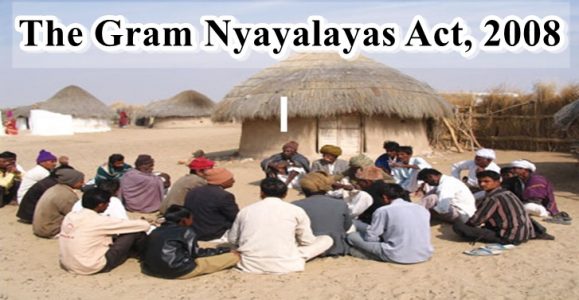Gram Nyayalayas – Salient Features, Jurisdiction, Powers, Authority

From Current Affairs Notes for UPSC » Editorials & In-depths » This topic
IAS EXPRESS Vs UPSC Prelims 2024: 80+ questions reflected
Justice is a foundational value of the Indian value system. After Independence, it expectedly became one of the basic principles on which our constitution is based. Despite that, there is an inequality in justice delivery. The time, space, and money quotient of the current judicial process makes it imperative to search for alternate and complementary mechanisms that can make the justice delivery more accessible, democratic, and effective. The formation of Gram Nyayalayas is such one step.
What is Gram Nyayalaya?
Gram Nyayalayas are mobile courts established in India for the speedy and low-cost justice system in rural India.
Why the Gram Nyayalayas are needed?
- The justice system which is supposed to uphold equality and justice is struggling to do both.
- Access to justice for the marginalized and poor sections of the society is a critical problem for us.
- Despite efforts of continuous progress, access to inexpensive and faster justice is a distant dream.
- The judicial pendency of cases is about 3.5 crores of which 87.5% are pending in district and subordinate courts (Economic survey 2018-19)
- The delays in judicial proceedings add up to already costly judicial processes. The rural population which mostly depends on agriculture and other manual work cannot afford it.
- The courts are at distant Taluka and district places making rural citizenry averse to follow judicial processes.
- Most of the people either don’t understand the detailed procedures or intimidated by the formal nature which makes them avoid it mostly.
What are the salient features of the Gram Nyayalayas Act, 2008?
The act came into force on 2nd October 2009.
- Establishment of Gram Nyayalaya
- the State Government, after consultation with the High Court, may establish one or more Gram Nyayalayas
- for every Panchayat at intermediate level or
- a group of contiguous Panchayats at the intermediate level in a district or
- where there is no Panchayat at intermediate level in any State, for a group of contiguous Gram Panchayats
- The Gram Nyayalayas established shall be in addition to the courts established under any other law for the time being in force.
- The headquarters of every Gram Nyayalaya shall be located at the headquarters of the intermediate Panchayat in which the Gram Nyayalaya is established or such other place as may be notified by the State Government.
- Appointments
- The State Government shall, in consultation with the High Court, appoint a Nyayadhikari for every Gram Nyayalaya
- A person qualified to be appointed as a Nyayadhikari must be eligible to be appointed as a Judicial Magistrate of the first class.
- While appointing a Nyayadhikari, representation shall be given to the members of the Scheduled Castes, the Scheduled Tribes, women and such other classes or communities
- Jurisdiction
- the Gram Nyayalaya shall exercise both civil and criminal jurisdiction in the manner and to the extent provided under the act.
- It shall try criminal and civil offences mentioned under the first and second schedule respectively.
- The centre and states can amend the aforementioned schedules.
- Working
- The Gram Nyayalayas are not bound by the Indian Evidence Act and follow the principle of natural justice.
- The Gram Nyayalaya shall exercise the powers of a Civil Court with certain modifications and shall follow the special procedure as provided in the Act.
- The Gram Nyayalaya shall endeavour to settle the disputes by bringing about conciliation between the parties as far as possible and it shall make use of the conciliators appointed for this purpose.
- The Gram Nyayalaya shall follow the summary procedure in case of criminal cases. A summary procedure is a legal procedure for enforcing the right that takes effect faster and more efficiently than ordinary methods.
- Nature of Judgement
The judgements/orders passed by the Gram Nyayalaya are deemed to be a decree
- Appeals
- Appeal in Civil cases– Appeals in civil cases shall lie to the District Court which shall hear and dispose it within six months from the date of filing of such appeal.
- Appeal in Criminal Cases– Appeals in criminal cases shall lie to the court of session which shall hear and dispose it within six months from the date of such appeal.
What is the importance of Gram Nyayalayas?
- It moves forward in the fulfillment of Article 39A of the Constitution which directs the state to provide for the free legal aid for the poor and marginalized sections of the society.
- It brings justice to the doorsteps of the rural India.
- Focus on conciliation takes care of rural societal harmony and prevents possible enmity due to rigorous judicial proceedings among the parties.
- Provision for summary procedures fastens the judicial proceedings.
- It takes the burden away from Taluka and District courts by providing alternate dispute redressal mechanism guaranteed by law.
- Power to try both civil and criminal cases ease of operation for the mobile courts.
- Focus on the principle of natural justice makes the platform less formal and makes it easy for the rural population to cooperate and actively engage in judicial procedures.
What is the status of the working of Gram Nyayalayas?
- As of January 2018, according to report by National Productivity council, across 11 states 320 Gram Nyayalayas have been notified, of which 204 have become operational.
- There is a lack of enthusiasm among states to establish Gram Nyayalayas.
- The Supreme court, in February 2020, asked state governments to issue notifications establishing Gram Nyayalayas as provided by the 2008 Act.
What are the issues in the working of the Gram Nyayalayas?
- The major issue is that of financial constraints along with the low response of the Bar.
- The lack of necessary requisites of Notary and stamp vendors, the reluctance of lawyers and police officials to invoke jurisdiction of Gram Nyayalayas adds to the reasons for non-performance.
- Many states have established regular courts at Taluka level and don’t feel the need to establish Gram Nyayalayas.
- There is an absence of a special cadre of Nyayadhikaris. The already burdened JFMCs or Civil judges preside over the Gram Nyayalayas which defeats the main purpose.
- Despite the expectation of proximity to the rural areas, some Gram Nyayalayas have been established in The Cities/ Towns.
- The Infrastructure provision for the mobile nature of courts is inadequate and there is very low enthusiasm to provide it as there is already huge pressure to run existing legal infrastructure.
- Duplicity of jurisdiction is an important issue due to the existence of family courts, labour courts.
- Lack of awareness about Gram Nyayalayas even among judicial and police-community makes it difficult for the scheme to succeed.
- The Existing Gram Nyayalayas are underperforming with a low level of disposal of cases.
- There is no scientific analysis of performance and effectivity of Gram Nyayalayas making it just another bureaucratic exercise and not pathbreaking alternate dispute resolution mechanism.
What can be done to improve the effectiveness and performance of the scheme?
- A separate cadre of Nyayadhikaris can be created so that Gram Nyayalayas have its dedicated cadre of Nyayadhikaris.
- Only the creation of separate cadre will not suffice. Appropriate training should be provided to Nyayadhikaris about legal procedures, local languages, etc.
- Separate buildings, its own staff, and other infrastructure must be made available and for that appropriate budgetary measures must be taken.
- Avoiding situations of parallel jurisdiction and duplicity of jurisdiction may go a long way in the success of Gram Nyayalayas.
- Scientific assessment of performance must be done periodically by respective High courts, and policy institutions like NITI Aayog can put things in perspective.
- Awareness generation campaigns through print and digital media and through panchayat raj institutions must be held to make people aware about the importance and ease of Gram Nyayalaya procedures so that they grow willingness to use the platform.
Conclusion
The directive principle under article 39A directs the state to make provisions for free legal aid to the poor and weaker sections of the society. The Scheme of Gram Nyayalayas is an important step in that direction. Its structure and working tries to remove many lacunae that the traditional judicial system has acquired over the years. In its success lies the hope that India can uphold the constitutional mandate of equality and justice to the people of India.
Practice Question for Mains
What are Gram Nyayalayas? Critically analyse its efficacy to fulfill the directives under Article 39A of the constitution.
If you like this post, please share your feedback in the comments section below so that we will upload more posts like this.


